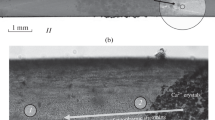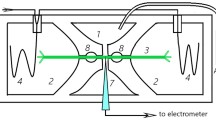Summary
By touching a cell ofPleurosira laevis, a centric diatom, the chloroplasts in the cortical cytoplasm immediately migrate to the nuclear cytoplasm which is located at the center of the cell. The time required for migration, is about 10 s and that for restoration is about 15 min. The touch could be replaced by an electric stimulation. A 7 V pulse for 1 ms was required for the induction of chloroplast assemblage. To obtain chloroplast assemblage in 50% of the cells, the amount of time and voltage required were inversely proportional. Higher concentrations of KCl also induced chloroplast assemblage. Neither contact nor electric stimulation in Ca2+ free medium induced chloroplast assemblage. Verapamil, a Ca2+ channel blocker, in medium suppressed the chloroplast assemblage. Ca2+ ionophore caused the chloroplast assemblage. These results suggested that the depolarization of the plasma membrane was a trigger of the induction of chloroplast assemblage and the influx of Ca2+ to the cytoplasm through the channel was essential for this. The chloroplast assemblage was transmitted successively to the other cells of the filamentous colony, though these cells were linked only by a mucilaginous substance. Furthermore, the transmission occurred in cells which were placed separately. The maximum distance possible for this jumping transmission was 200 μm in the culture medium. To search for the release of any chemical transmitter, contact stimulation was applied to one cell at the middle of a filamentous colony which was placed in water streaming along the axis of the filament. Chloroplast assemblage was induced more in downstream cells than in upstream ones. This result suggested the existence of some substance which mediated the transmission of the stimulation.
Similar content being viewed by others
References
Barry WH (1969) Coupling of excitation and cessation of cyclosis inNitella. Role of divalent cations. J Cell Physiol 72: 153–160
Bold HC, Wynne MJ (1978) Introduction to the algae: structure and reproduction. Prentice-Hall, New York
Chen S, Li CW (1991) Relationships between the movement of chloroplasts and cytoskeletons in diatoms. Bot Mar 34: 501–511
Compère P (1982) Taxonomic revision of the diatom genus Pleurosira (Eupodiscaceae). In: Simonsen R (ed) Bacillaria, vol 5. J Cramer, Braunschweig, pp 165–190
Guharay F, Sachs F (1984) Stretch-activated single ion channel currents in tissue-cultured embryonic chick skeletal muscle. J Physiol 352: 685–701
Hille B (1992) Ionic channels of excitable membranes, 2nd edn. Sinauer Associates, Sunderland, MA, pp 140–169
Kikuyama M, Tazawa M, Tominaga Y, Shimmen T (1996) Membrane control of cytoplasmic streaming in characean cells. J Plant Res 109: 113–118
Kishimoto U (1965) Ionic composition of the cytoplasm ofNitella flexlis. Plant Cell Physiol 6: 507–518
Morris CE, Sigurdson WJ (1989) Stretch-inactivated ion channels coexist with stretch activated ion channels. Science 243: 807–809
Nagai R (1993) Regulation of intracellular movements in plant cells by environmental stimuli. Int Rev Cytol 145: 251–310
Naitoh Y, Eckert R (1969) Ionic mechanisms controlling behavioral responses ofParamecium to mechanical stimulation. Science 164: 963–965
Ping Z, Mimura T, Tazawa M (1990) Jumping transmission of action potential between separately placed internodal cells ofChara corallina. Plant Cell Physiol 31: 299–302
Senn G (1919) Weitere Untersuchungen über Gestalts- und Lageveränderungen der Chromatophoren, IV und V. Z Bot 11: 81–139
Shihira-Ishikawa I, Ohsu T (1995) Distribution and migration of mitochondria in centric diatomPleurosim laevis (Ehrenberg) Compère. Diatom 11: 1–7
Sokabe M, Sachs F, Jing Z (1991) Quantitative video microscopy of patch clamped membranes stress, strain, capacitance, and stretch channel activation. Biophys J 59: 722–728
Tabata T (1990a) Electronic transmission of an action potential between two separated internodal cells ofChara through a bridge. Plant Cell Physiol 31: 513–518
— (1990b) Ephaptic transmission and conduction velocity of an action potential inChara internodal cells placed in parallel and in contact with one another. Plant Cell Physiol 31: 575–579
Tazawa M, Kishimoto U (1964) Studies onNitella having an artificial cell sap. II. Rate of cyclosis and electric potential. Plant Cell Physiol 5: 45–59
Trewavas A, Knight M (1994) Mechanical signalling, calcium and plant form. Plant Mol Biol 26: 1329–1341
Williamson RE (1993) Organella movement. Annu Rev Plant Physiol Mol Biol 44: 181–202
Yang XC, Sachs F (1989) Block of stretch-activated ion channels inXenopus oocytes by gadolinium and calcium ions. Science 243: 1068–1071
Author information
Authors and Affiliations
Rights and permissions
About this article
Cite this article
Makita, N., Shihira-Ishikawa, I. Chloroplast assemblage by mechanical stimulation and its intercellular transmission in diatom cells. Protoplasma 197, 86–95 (1997). https://doi.org/10.1007/BF01279887
Received:
Accepted:
Issue Date:
DOI: https://doi.org/10.1007/BF01279887




